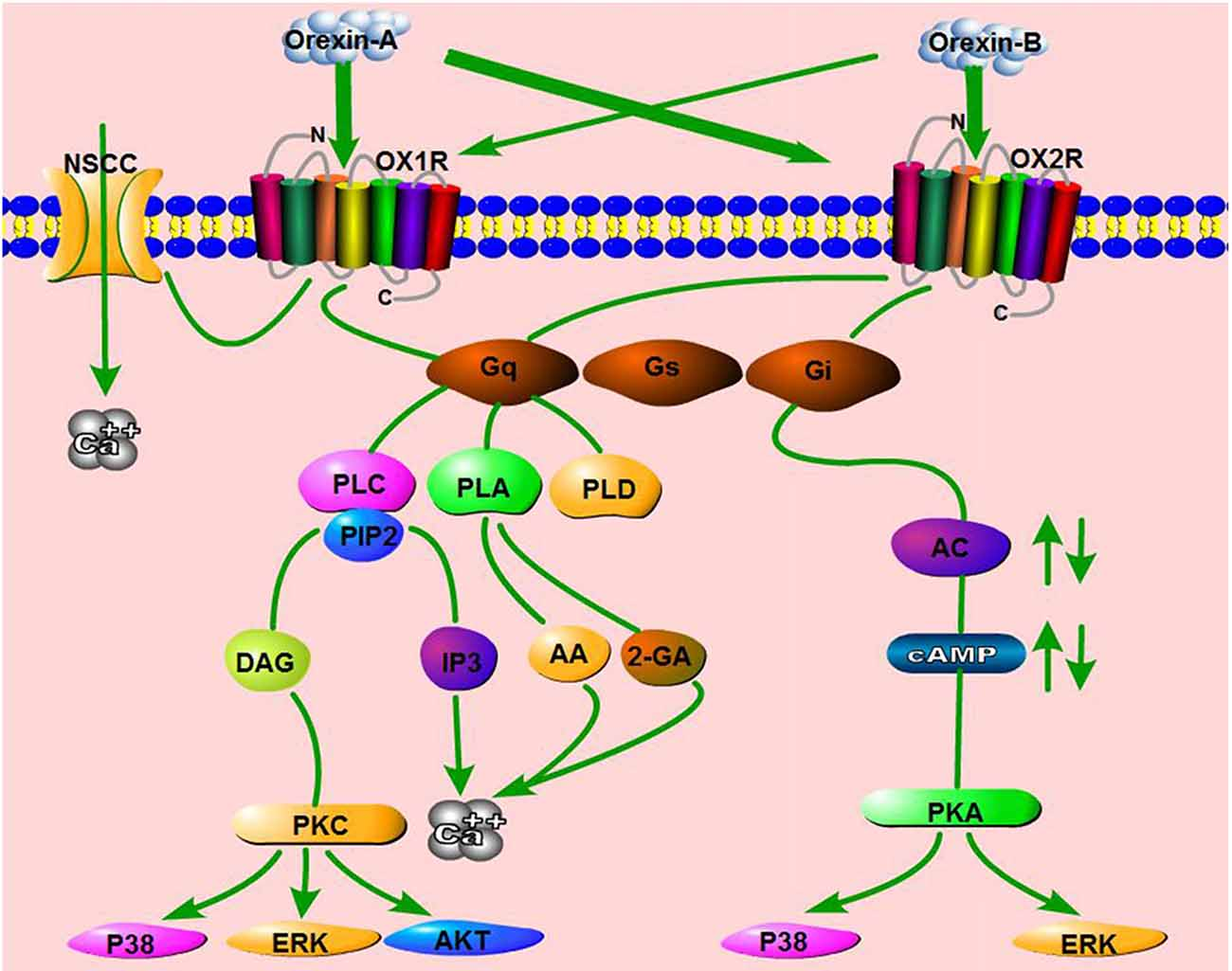Orexin A (human, rat, mouse) |
| رقم الكتالوجGC12522 |
أوريكسين أ (إنسان، فأر، فأر) ، يدير عمليات متنوعة في المركزية والطرفية.
Products are for research use only. Not for human use. We do not sell to patients.

Cas No.: 205640-90-0
Sample solution is provided at 25 µL, 10mM.
Orexin A (human, rat, mouse), orchestrates diverse central and peripheral processes[1]. Orexin A (human, rat, mouse) is a specific, high-affinity agonist for G-protein-coupled receptor OX1R. Orexin A (human, rat, mouse) has a role in the regulation of feeding behavior. Orexin A (human, rat, mouse) is an effective anti-nociceptive and anti-hyperalgesic agent in mice and rats[2].Orexins first bind OXRs, which in turn activate at least three subtypes of G-proteins (Gq/11, Gi/o, and Gs) or other proteins (e.g., β-arrestin). These effectors subsequently regulate phospholipases, ion channels, and protein kinases, ultimately triggering the activation of various downstream signaling pathways [3,5].
Orexin-A induced a transient increase in [Ca2+ ]i in CHO/OX1R cells in a dose-dependent manner, but failed to induce detectable [Ca2+ ]i transients in mock transfected CHO cells. The calcium mobilization is likely caused by the activation of the Gq class of heterotrimeric G proteins[6].The calculated concentration of orexin-A required to induce half-maximum response (EC50 ) was 30 nM. The concentration of unlabeled Orexin-A required to displace 50% of specific radioligand binding (IC50 ) was 20 nM. Repeated competitive radioligand binding assays and [Ca2+ ]i transient dose-response studies using stably transfected CHO cells expressing the human OX2R cDNA. The results demonstrated that OX2R is indeed a high-affinity receptor for human orexin-B, with an IC50 of 36 nM in the binding assay and an EC50 of 60 nM in the [Ca2+ ]i transient assay . Orexin-A had high affinity for this receptor, with 38 nM IC50 and 34 nM EC50 values.These findings confirm that orexin-A is indeed a specific, high-affinity agonist for OX1R.
The Orexin A concentration in cerebrospinal fluid (CSF) was abnormally low in seven of nine people with narcolepsy, implying that orexin transmission was deficient in these patients[7].In a later study, the same group reported a dramatic decrease in the CSF Orexin A levels in 32 of 38 successive narcolepsy-cataplexy cases [8].On the basis of these findings, they concluded that Orexin is deficient in most cases of human narcolepsy, suggesting possible diagnostic applications. Furthermore, the number of orexin neurons is reduced by 85%-95% in the LH of patients with narcolepsy [9]. Orexin mRNA and neuropeptide are completely absent in hypothalamus, pons and cortex of narcolepsy patients, and the secretory signal sequence of the orexin gene is deficient in the most serious cases of early onset narcolepsy [10].These observations further prove that narcolepsy is associated with deficiency in the orexin system.

The binding of orexins to orexin receptor type 1 (OX1R) or OX2R stimulates Gq or Gi subtypes, which subsequently induce the activation of phospholipase C (PLC), phospholipase A (PLA), phospholipase D (PLD) or Adenylyl cyclases (AC), ultimately resulting in an increase in cytosolic Ca2+ and a downstream cascade response. In addition, OA binds OX1R and elevates Ca2+ by activating nonselective cation channels (NSCCs) [11].
References:
[1]. Bingham S, et al. Orexin-A, an hypothalamic peptide with analgesic properties. Pain. 2001 May;92(1-2):81-90.
[2]. Sakurai T, et al. Orexins and orexin receptors: a family of hypothalamic neuropeptides and G protein-coupled receptors that regulate feeding behavior. Cell. 1998 Feb 20;92(4):573-85.
[3].Dalrymple M B, Jaeger W C, Eidne K A, et al. Temporal profiling of orexin receptor-arrestin-ubiquitin complexes reveals differences between receptor subtypes[J]. Journal of Biological Chemistry, 2011, 286(19): 16726-16733.
[4].Kukkonen J P, Leonard C S. Orexin/hypocretin receptor signalling cascades[J]. British journal of pharmacology, 2014, 171(2): 314-331.
[5].Leonard C S, Kukkonen J P. Orexin/hypocretin receptor signalling: a functional perspective[J]. British journal of pharmacology, 2014, 171(2): 294-313.
[6].Hepler J R, Kozasa T, Gilman A G. [16] Purification of recombinant Gqα, G11α, and G16α from Sf9 cells[M]//Methods in enzymology. Academic Press, 1994, 237: 191-212.
[7].Nishino S, Ripley B, Overeem S, et al. Hypocretin (orexin) deficiency in human narcolepsy[J]. The Lancet, 2000, 355(9197): 39-40.
[8].Nishino S, Ripley B, Overeem S, et al. Low cerebrospinal fluid hypocretin (Orexin) and altered energy homeostasis in human narcolepsy[J]. Annals of Neurology: Official Journal of the American Neurological Association and the Child Neurology Society, 2001, 50(3): 381-388.
[9].Thannickal T C, Moore R Y, Nienhuis R, et al. Reduced number of hypocretin neurons in human narcolepsy[J]. Neuron, 2000, 27(3): 469-474.
[10].Peyron C, Faraco J, Rogers W, et al. A mutation in a case of early onset narcolepsy and a generalized absence of hypocretin peptides in human narcoleptic brains[J]. Nature medicine, 2000, 6(9): 991-997.
[11].Wang C, Wang Q, Ji B, et al. The orexin/receptor system: molecular mechanism and therapeutic potential for neurological diseases[J]. Frontiers in molecular neuroscience, 2018, 11: 220.
Average Rating: 5 (Based on Reviews and 19 reference(s) in Google Scholar.)
GLPBIO products are for RESEARCH USE ONLY. Please make sure your review or question is research based.
Required fields are marked with *




